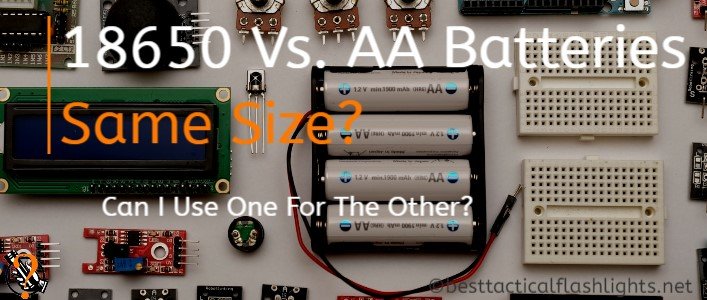Are 18650 Batteries and AA Batteries the same?
No they are not.
They have different sizes, capacities, and voltages.
Usually electronics that are designed to run on one will not run on the other.
So lets see what the 18650 vs AA Battery battle is all about.
18650 Vs AA Battery Match Up
18650 Battery Basics
Using the term 18650 battery is pretty specific.
First it is referencing a rechargeable lithium ion battery which are the core of most rechargeable flashlights.
There is a wide range of chemistries for li-ion batteries but they all are based on lithium ions moving from the negative electrode through an electrolyte to a positive electrode while discharging. They move back when recharging.
All 18650 batteries are lithium ion batteries but not all lithium ion batteries are 18650.
Size
18650 is specifically talking about the dimensions and size of the battery in millimeters.
18mm in diameter and 65mm tall.
Electricity Profile
18650 batteries have a cell voltage of 3.6-3.7V which is the average voltage during a complete discharge. During the discharge the range is from 4.2V to 2.5V but in general you should not go below 3V for the health of the battery.
Capacity and Discharge Rate
Capacity is measured in milliamp hours (mAh). 18650 batteries currently range between 2000 mAh to 3500 mAh.
Discharge Rate is measured in amperes (A). 18650 batteries currently range between 4 A to 20 A
These two things play against each other a little. Usually batteries with high amps will have lower capacity. For flashlight enthusiasts that like super high brightness levels high amps are better. These would be IMR batteries.
But, if you are looking for long battery life then something with high capacity and low amps would be good.
One thing to keep in mind with li-ion batteries is that they have a self discharge rate of around 10% per month. So, these are not batteries that you want to store or put in devices that just sip power since the battery will just die in a couple of months either way.
One of the biggest benefits of li-ion rechargeables is that they can be recharged over 1000 times and they do not have a memory issue. You should be able to recharge them to the highest capacity they whole time.
AA Battery Basics
In the past A batteries were a specific size, volts, and chemistry. Once electronics got smaller and battery technology progressed sub-A size batteries were developed and that is where AA, AAA, and AAAA batteries come from.
Now days AA on a battery is talking almost strictly about the size.
You can have AA alkaline batteries, lithium batteries (not li-ion), and Nickel based rechargeable.
Size
The size of an AA battery is between 13.5-14.5mm in diameter and between 49.2-50.5mm tall, including the button top.
Electricty Profile
AA batteries have a cell voltage of 1.5V. During the discharge the range is from 1.5V to 0.9V but in general they will not work below 1V.
Capacity and Discharge Rate
Alkaline batteries have a capacity between 1700-2850 mAh while Ni-MH have a capacity between 600-2750 mAh
The voltage of AA batteries by standard is 1.5 Volts.
But devices made to run on AA batteries are usually fine with 1.2 Volts since popular Nickel-Cadmium (NiCd) and Nickel-Metal Hydride (NiMH) rechargeable batteries in the AA size are 1.2 Volts. There are lots of types of batteries.
A great thing about old school Alkaline batteries is that they have a super low self discharge rate of 0.3%. So they can be used for prepper situation or to just keep in a drawer.
On the other side of the AA spectrum Ni-MH which are our favorite rechargeables at this size have a self discharge rate of 20% per month. So after 4 months or so you are super low anyway. These batteries are great for things that kill batteries really fast anyway.
One more thing to keep in mind with Ni-MH is that the batteries have a memory so if you do not discharge and recharge them correctly you will lose capacity over their 500 to 800 recharges.
Difference Between 18650 and AA Batteries
Both of the names are referencing a size but these sizes are way different. Another thing is that 18650 is always talking about a li-ion rechargeable battery where AA can be a primary battery or a rechargeable battery.
18650 batteries do not have a memory effect as they recharge so you will have high capacity the entire time. While Ni-MH have a memory effect so as you cycle them you will lose power.
Are 18650 Batteries Bigger Than AA?
18650 batteries are way bigger than AA batteries. You will have a hard time fitting one into the others spot and getting it to work.
Can I Use AA Battery Instead Of 18650?
If a device is asking for a li-ion 18650 batter then it is expecting somewhere between 3 to 4.5 Volts to run. AA batteries run between 1.2 to 1.5 Volts.
So, unless the device specifically says that it can run off of both power sources it will not be possible.
Conclusion
So you can not use one for the other.
These are different things all together. If you are looking to run high power electronics that drain batteries quickly then li-ion batteries are the way to go.
They do not have any memory and they can discharge at a high rate. The down fall of these batteries is that they self-discharge.
If you are looking for long term battery storage then primary batteries are the way to go. They are only for one use but they can last for years without
Hope you found what you are looking for on our site. If you are looking for a flashlight when you found us check out our overall flashlight buyers guide where you can get down to what you really want.
